Construction
All CB guitars feature:

|
All solid woods - no laminates or synthetic materials |
|
|

|
Hand-scalloped braces & tap-tuned tops |
|
|

|
Hand-shaped necks to customer's specifications |
|
|

|
Hand-crafted genuine bone nuts & saddles |
|
|

|
Genuine bone bridge pins |
|
|

|
Hand-rubbed Nitrocellulose Lacquer finishes |
|
|

|
Quality hardshell case |
|
|

|
Limited Lifetime Warranty |
Chris' craftsmanship
and attention to detail and tone quality assure you of the finest instruments available
today, and Chris' artistry and his eye for aesthetics assure that his
instruments will be as beautiful to the eye as they are pleasing to the ear.
The following pictures are meant to show you some of the
craftsmanship that goes into the creation of each CB guitar.
Click this link for sound
samples of CB instruments.
Click Here for Step-By-Step
Construction of a CB Model J

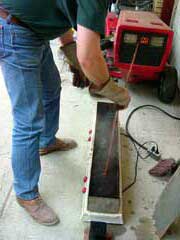
Chris' first step in constructing a CB Guitar is bending the
sides. Here Chris is removing a quilted Mahogany side from his
boiling trough. Boiling time varies by wood species and amount of
figure; typically, figured wood must be boiled for a longer period
of time to allow the wood to bend without cracking. Some species
require no boiling at all, only a short soaking.
(click picture for a larger version) |
|
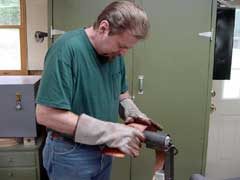
Chris bends the side wood over a heated bending iron of his own
design & construction.
(click picture for a larger version) |
|
|
|
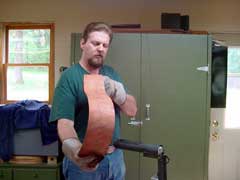
A steady hand and a practiced eye are required to bend the sides
without cracking the wood...
(click picture for a larger version) |
|

...and to achieve the closest possible fit to the body
form without twisting or distorting the wood.
(click picture for a larger version) |
|
|
|
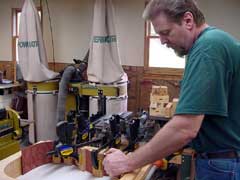
Chris clamps the side wood into his hand-made body form.
Carefully bending the wood to closely fit the form eliminates the
possibility of the wood cracking while in the form.
(click picture for a larger version) |
|

The center spreader blocks lock the body into the form, and
hold the gentle curve of the waist area.
(click picture for a larger version) |
|
|
|

Adjustable clamps allow Chris to adjust the tension of the body
form as necessary.
(click picture for a larger version) |
|
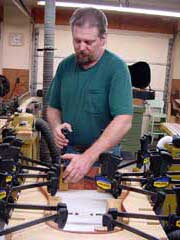
The body will remain clamped in the form until it is able to
hold its shape on its own, without distortion. Clamping time
varies by wood species.
(click picture for a larger version) |
|
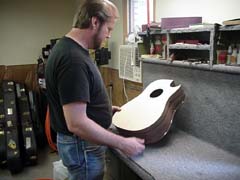
Chris assembles the body of an Indian Rosewood
"Herringbone" Cutaway. |
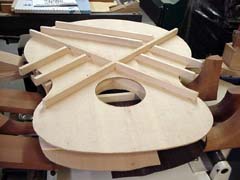
Guitar top awaiting tuning and scalloping of braces. |
|
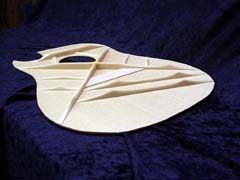
All CB guitars feature hand-scalloped braces of select Sitka Spruce and
tap-tuned tops for maximum tonal response and volume. |
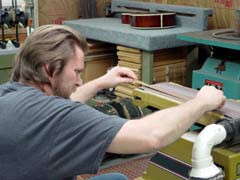
Chris hand-fabricates kerfed lining from Mahogany stock. |
|
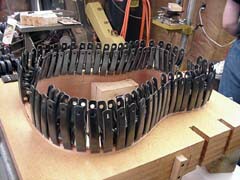
Lining is glued to sides in body form. |
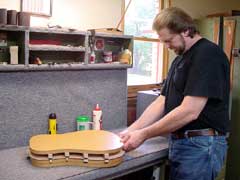
Back braces are located and glued in a gluing jig
fabricated by Chris. |
|
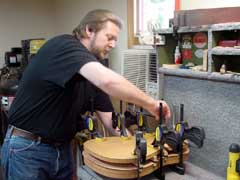
Chris clamps the guitar braces to the back in the
gluing jig. |
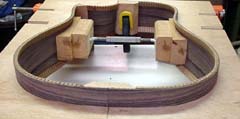
Indian Rosewood "Herringbone" Cutaway body in form. |
|

Indian Rosewood "Herringbone" Cutaway back awaiting
hand-shaping of braces, shown with body in form. All CB guitars feature
hand-shaped back braces of select Sitka Spruce. |
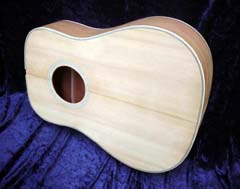
Front view of unfinished Mahogany "Herringbone" body. |
|

Rear view of unfinished Mahogany "Herringbone" body. |

Front view of unfinished Indian Rosewood "Herringbone" body. |
|
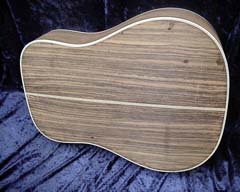
Rear view of unfinished Indian Rosewood "Herringbone" body. |
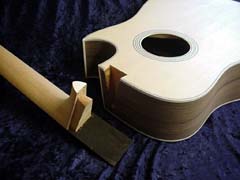
All CB guitars feature hand-fit dovetail neck joints. The dovetail neck
joint, while harder to accomplish properly than modern
"shortcuts", is still the finest method ever devised for neck
attachment. |
|
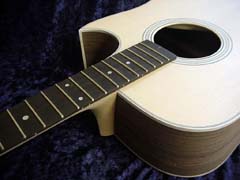
The dovetail neck joint allows for maximum tone transmission from neck
to body, maximum strength, optimum playing action, and ease of future neck
repairs. |
 In
order to introduce an adjustable truss rod that adjusts neck tension
through the sound hole, some manufacturers drill a hole through the
transverse brace that lies underneath the fretboard extension. This
weakens this major brace in its most critical area, and leads to problems
such as top distortion and neck block displacement. Beware of guitars
featuring this type of neck adjustment! |
|

This picture, taken with a mirror looking at the underside of the top
at the neck block through the sound hole, shows Chris' solution to this
problem. Rather than drill through the transverse brace to allow access to
the truss rod adjustment nut, all CB guitars feature an adjustment nut
that is accessible through the end of the neck block by simply reaching
inside the guitar behind the transverse brace. This allows for
easily-accessible neck adjustment while maintaining the structural
integrity of the guitar. |
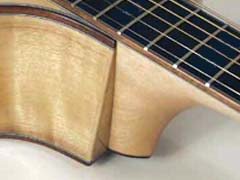
"Standard" acoustic guitar
cutaways used by other makers are typically
just that: the upper treble bout of the
guitar is simply removed to allow more
access to the upper frets. Most makers do
not take the extra care to follow the angle
of the heel to the back of the guitar. This
results in an unsightly "wedge" of
wood by the treble side of the neck heel
that really gets in the way when playing in
the higher positions. |
|

The CB cutaway follows the angle of the
neck heel to the back of the neck for
easier access and a better appearance.
This requires a great deal of work, as a
"compound radius" is required,
but the playability and beauty of this
cutaway is worth the extra effort. Because
of this compound radius, CB cutaways are a
"Florentine" (sharp) design
rather than a "Venetian"
(rounded) design. |

Chris hard at work, cutting pearl for inlays. |
|
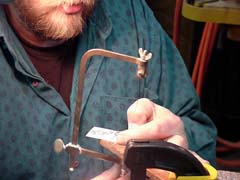
All inlays are hand-cut and hand-inletted by Chris. |
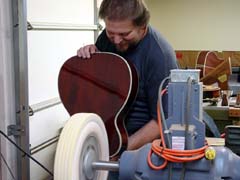
Chris buffing the finish of a
CB-ROM. |
|
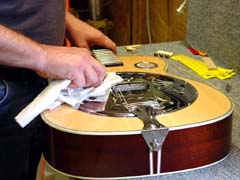 Final
cleaning & setup of a CB-ROM. |

Last modified: November 28, 2015
|
![]()